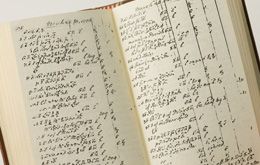...build belief in yourself and as you do this, you reactivate the success mechanism -- the servo-mechanism -- within you. This implies that your eyes are open to opportunities that arise because you want to see them and reach them -- without stepping on other people's toes, but also without tripping over your own toes.
-Maxwell Maltz, Psycho-Cybernetics and Self-Fulfillment, p.8
The term cybernetics stems from the Greek κυβερνήτης (kybernētēs, steersman, governor, pilot, or rudder — the same root as government). In 1 Corinthians 12:28 (cf Prov 1.5; 11.14 Septuagint) κυβέρνησις is one of the gifts of the Holy Spirit. Today the word is generally used in the context of Information Systems.
The significance of cybernetics to anthropology, sociology, physiology, and psychology was appreciated by the father of modern cybernetics, Norbert Wiener and others. He wrote, "Drs McCulloch and Fremont-Smith have rightly seen the psychological and sociological implications of the subject.... The need of including psychologists had indeed been obvious from the beginning. He who studies the nervous system cannot forget the mind, and he who studies the mind cannot forget the nervous system. (Wiener, Cybernetics, p.26). Thus the relevance of cybernetics to dreaming and dreams.
Over the years I have come to experience and think of dreams as an inner guidance system, a rudder or steering mechanism to help one navigate through life's difficulties. Dreams can be a useful problem-solving resource.
A little while ago I had been reading John Kehoe (Quantum Warrior, p.120f) explaining how one can consciously dream solutions to problems through a process he calls "dream incubation". Top of my mind at the time was an awful conflict situation I had had at work. It was an accounting environment and the problem was one of financial accountability. I was a programmer and a technician but not an accountant so felt inadequate to deal with it. The problem was a complex legal-forensic one and a very serious one at that. It affected me deeply. Kehoe led me to think differently about the problem by reactivating the "servo-system" within myself.
So, on going to bed I kept repeating the question that was running through my mind, "What must I do about this situation at work? Do I continue working at it or do I just resign from it, throw in the towel, and not get involved?" With this concern on my heart I went to sleep.
I woke early the next morning dreaming that I was at a radio observatory of sorts like the one at Hartebeesthoek where I had previously worked. In a mysterious way my dream had latched on to a context I could easily relate to as a technician and programmer. In the dream we weren't getting a clear "picture" of a critical deep space object that we were looking at. I suggested the noise level was anomalously high, distorting the picture, and that we should check the signal to noise ratio (SNR is a standard measurement in radio telecommunication). We needed to take corrective action in order to see the big picture by reducing internally generated dissonance . (See Gestalt and Cybernetics.) And so it happened.
Mariner 6 photo enhancement.
First panel is the original picture. The top-right panel
is the system noise pattern which when digitally
applied to the original clarifies it as in the lower pictures.
Photo Credit: NASA
It was quite some dream! As a direct response to my question, the the dream seemed to be advising me that the problem should not simply be ignored but that it had to be addressed. It also indicated the kind of contribution I could make.
Remarkable as my dream was, dreams of this nature are not unusual. Indeed, one of the most significant instances comes from my own Methodist tradition. John Wesley wrote parts of his Journal in code, intentionally guarding its contents deliberately hiding it by means of a cipher. Sometimes there is good reason for encoding transmissions. In this case, it was not noise that hid the true content but encoding.
John Wesley had left behind a Journal much of it written in an indecipherable code. In 1909, the Rev. Nehemiah Curnock was poking around through a secondhand bookstore when he came across a treasure - John Wesley's personal Bible, with marginal handwritten notes in the same mysterious code. Curnock bought the Bible, studied it, and then forgot about it. One night, shortly thereafter, while deep in sleep, Reverend Curnock had a dream - he saw Wesley's Journal, and on one page the code was deciphered. Waking, he had the key. Remembering his dream, he examined Wesley's code in the Bible, and unlocked the mystery. Curnock alludes to the dream in his introduction to his edition of the Journal of John Wesley. His dream was cybernetic, it had guided and directed him to the key that would help unlock the mysterious cipher John Wesley had used.
Dreams do that for us! They open us to new possibilities helping us to see the underlying issues and get the "bigger picture".
oOo
Further Reading:
Two interesting articles by George Butler:
"Minister's Remarkable Dream", http://news.google.com/newspapers?nid=1891&dat=19761010&id=-6QfAAAAIBAJ&sjid=OtYEAAAAIBAJ&pg=1360,1216912
"Dreams often provide key to many of world's mysteries", http://news.google.com/newspapers?nid=1891&dat=19750816&id=wKcfAAAAIBAJ&sjid=VtYEAAAAIBAJ&pg=811,2666820
Recent Wesleyan research has built on the earlier work of Nehemiah Curnock. Richard Heitzenrater has devoted much of his time decoding the diaries of John Wesley http://divinity.duke.edu/publications/2008.10/features/code/index.htm. Charles Wesley also coded large sections of his Journal which has been cracked by Professor Kenneth Newport http://www.dailymail.co.uk/news/article-1049285/Coded-diary-reveals-secret-sex-scandal-haunted-Methodist-founder-Charles-Wesley.html
©Colin G Garvie HomePage: http://www.garvies.co.za

